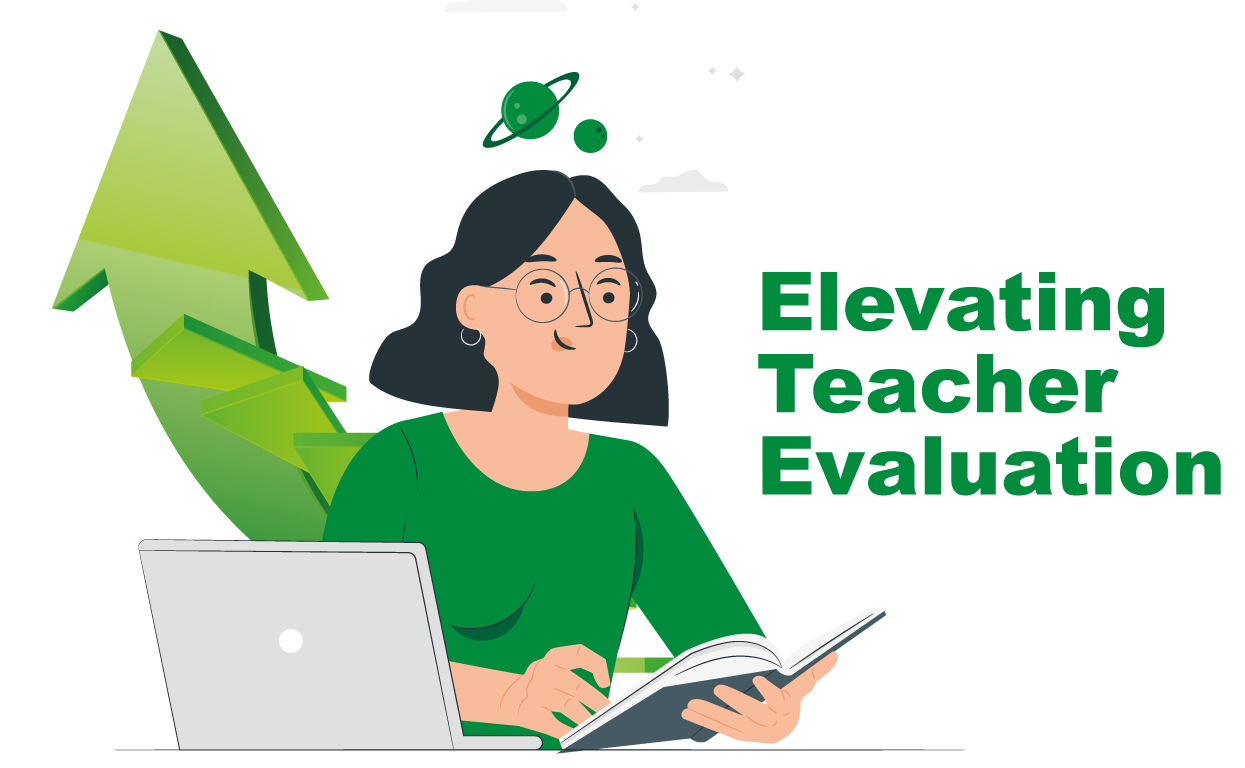Evaluating teacher effectiveness guarantees high-quality instruction and helps teachers grow. Or does it? Research shows that some models of teacher evaluation have the exact opposite effect. It’s understandable: being evaluated is anxiety-inducing. Imagine going about your work when you become aware that someone is watching and judging your every move. As the evaluator, it’s probably not your favorite part of the job either.
So, as a school leader, how can you change perceptions about the dreaded evaluation? Start by adopting a coaching mindset, giving formative feedback, and making growth visible. These actions will leave teachers feeling supported rather than judged.

The Difference Between Teacher Evaluation & Coaching
First, let’s get clear on the roles that teacher evaluation and coaching play in an instructional support system. The two serve unique functions but are inextricably linked. The first step in improving teacher effectiveness is understanding and respecting the differences between evaluation and coaching.
Teacher evaluation is the process of reviewing and rating teacher effectiveness in the classroom at a single point in time. Authentic teacher coaching is ongoing, supportive, and strengths-based. It puts teachers at the center of their own professional learning journey. The aim of teacher evaluation is to ensure teachers meet the minimum standard of quality. Teacher coaching invites growth beyond the minimum. Both have their place in an effective instructional support system.
Historically, teacher evaluations often operated as a “check-the-box” activity where administrators would sit in on a lesson once or twice a year, make some notes, and leave feedback that was either rarely actionable or lacked follow-up. This type of superficial evaluation can lead to distrust and anxiety. It’s essential to understand the roots of teacher evaluation to acknowledge past mistakes and build a future-oriented, growth-focused approach.

Adopt a coaching mindset
A major challenge in many traditional evaluation systems is that they focus on what’s lacking – the deficits. While identifying areas for improvement is necessary, the power of positive reinforcement can’t be overlooked. A strengths-based model focuses on leveraging a teacher’s existing skills and talents, then building upon them. This approach not only boosts teacher morale but often results in a more accelerated professional growth trajectory.
You can have immediate impact when you approach your role with the mindset of a coach rather than an evaluator. An evaluator looks at what is happening, forms an opinion, and articulates what should be happening. A coach articulates what was observed and encourages teachers to reach higher while giving them the support to do so.
By making this small shift, you build trust with teachers. But make sure you are doing your homework and citing tried-and-true best practices. Relying on your own opinions can erode trust and cause confusion.

Embed Formative Feedback
Another step towards growth-oriented teacher support is formative feedback. We won’t dance around the fact that providing feedback is one of the hardest parts of a principal’s job – especially when feedback is negative and causes teachers to become defensive of their craft. This tends to happen when you don’t provide much to back it up or when it’s a result of a one-time classroom visit. Defensiveness usually boils down to a lack of trust.
To truly transform perceptions around evaluations, schools should strive to create a culture where feedback is not an event but an ongoing conversation. In this environment, every classroom observation, follow-up debrief, or staff meeting becomes an opportunity to build trust and promote growth.
Take the time to visit classrooms. Make it a point to know each teacher’s professional learning goals. Identify individual strengths and celebrate them. And don’t forget to offer feedback in a timely manner if you want it to land well. By upping the frequency of feedback and recognizing strengths, teachers will come to rely on and expect your support. When feedback is embedded in the school’s DNA, evaluations become less about judgment and more about collective progress.

Make growth visible
Teachers want ownership of their professional development. They want to be able to track their growth over time. They want to be able to visualize their progress. Google docs/ paper and pen systems leave much to be desired when it comes to motivating teachers towards growth. And they leave much room for error and oversight.
That’s why you need better technology to manage coaching and evaluation; technology that allows both school leaders and teachers alike to visualize data and spot trends, and keep all feedback and classroom artifacts (e.g. videos, documents) in one easily accessible place.
While technology alone cannot replace the human touch required in evaluations and coaching, it can undoubtedly act as a force multiplier. On top of data visualization, modern instructional support platforms can also facilitate more efficient feedback loops, foster collaboration, and provide resources for teachers’ continuous growth. Embracing technology is no longer a luxury but a necessity in the evolving educational landscape.
Additionally, it’s a lot to ask a school leader to provide one-on-one coaching and feedback on a regular basis. And it’s a shame to do the work but not be able to visualize individual and school-wide progress. When you can make sense of the data, you can offer targeted support and differentiated professional learning.
FAQs about Elevating Teacher Evaluation
Teacher evaluation is a process where a teacher’s effectiveness is reviewed and rated at a specific point in time, typically to ensure they meet set standards. Coaching, on the other hand, is an ongoing, supportive initiative that aims to foster continuous growth in teachers beyond just meeting basic standards.
Adopting a coaching mindset transforms the evaluative process from one that might feel judgmental to one that is supportive. This approach builds trust with teachers, promotes open dialogue, and emphasizes growth and development over mere compliance.
Formative feedback is continuous and allows teachers to make real-time adjustments to their teaching methods. It’s based on frequent classroom visits and interactions, making it more reflective of the teacher’s overall performance. This consistent feedback helps in building trust, and teachers tend to be more receptive to suggestions when they feel supported.
Visualizing growth provides a tangible representation of a teacher’s professional journey. It allows for immediate feedback, sets clear goals, promotes reflection, and creates a sense of accountability. By seeing their progress mapped out, teachers can better appreciate their achievements and identify areas needing further development.
Technology streamlines the evaluation process by providing efficient tools for observation, feedback, and tracking progress. It offers a centralized platform where both teachers and evaluators can access data, review feedback, and visualize growth. By reducing the manual workload and enhancing accuracy, technology allows educators and school leaders to focus more on constructive dialogue and development strategies.
Final Thoughts on Elevating Teacher Evaluations
In the words of Charlotte Danielson, “a commitment to professional learning is important, not because teaching is of poor quality and must be ‘fixed,’ but rather because teaching is so hard that we can always improve it.”(1) This is the message we want to impart to teachers about coaching and evaluation. Giving all students the opportunity to thrive isn’t easy. Authentic coaching is how you, as a leader, show that you and your teachers are in it together.
We’re always happy to help and provide input where we can. If you have questions about your instructional support system, we’d love to talk to you. Schedule a complimentary strategy session with a Bullseye expert!


